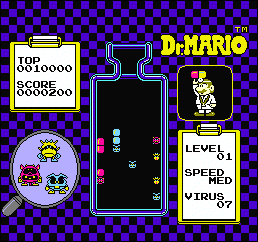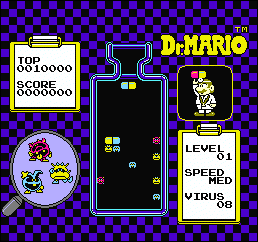 The Game: Now that he’s got plumbing and rescuing princesses out of the way, Mario ‘s gone and finished his medical degree. You have to help him dish out just the right pills to get rid of the corresponding viruses, matching them by color. Stacking at least three pill segments of the same color on top of or next to a virus will kill it, but the leftover pill segments will fall into place, possibly keeping you from treating other problems. (Mismatched pills can be eliminated too, by creating a stack of four segments of the same color.) Allowing too many pills to clog the works will end the game. (Nintendo, 1990)
The Game: Now that he’s got plumbing and rescuing princesses out of the way, Mario ‘s gone and finished his medical degree. You have to help him dish out just the right pills to get rid of the corresponding viruses, matching them by color. Stacking at least three pill segments of the same color on top of or next to a virus will kill it, but the leftover pill segments will fall into place, possibly keeping you from treating other problems. (Mismatched pills can be eliminated too, by creating a stack of four segments of the same color.) Allowing too many pills to clog the works will end the game. (Nintendo, 1990)
Memories: Okay, it’s no Microsurgeon (and it’s no Tetris either), but there’s something addictive about whatever pills Mario was prescribing during his brief medical career.
 My biggest criticism of Dr. Mario has always been that it’s more or less a generic, non-name-brand copy of certain elements of Tetris. That doesn’t mean the game’s not fun; on the contrary, it’s a lot of fun. It’s different enough to be a different species in the same petri dish as Tetris, more or less. It’s also far, far easier for the player to create a game-killing logjam in Dr. Mario than it is in Tetris; fear not, malpractice makes perfect.
My biggest criticism of Dr. Mario has always been that it’s more or less a generic, non-name-brand copy of certain elements of Tetris. That doesn’t mean the game’s not fun; on the contrary, it’s a lot of fun. It’s different enough to be a different species in the same petri dish as Tetris, more or less. It’s also far, far easier for the player to create a game-killing logjam in Dr. Mario than it is in Tetris; fear not, malpractice makes perfect.
 One wonders, though, would Dr. Mario get a clean bill of health today, or would it somehow be viewed, though a post-war-on-drugs lens, as a game that’s somehow peddling a pro-drug message? (That may sound like a facetious question, but bear in mind that the first protests against violence in video games involved atrocities visited upon stick figures.) In any case, Dr. Mario stands the test of time as one of the better derivations from Mario’s main plotline, if indeed any such thing can be said to exist.
One wonders, though, would Dr. Mario get a clean bill of health today, or would it somehow be viewed, though a post-war-on-drugs lens, as a game that’s somehow peddling a pro-drug message? (That may sound like a facetious question, but bear in mind that the first protests against violence in video games involved atrocities visited upon stick figures.) In any case, Dr. Mario stands the test of time as one of the better derivations from Mario’s main plotline, if indeed any such thing can be said to exist.
